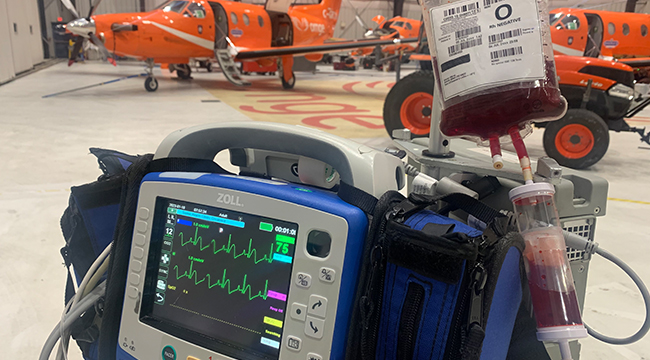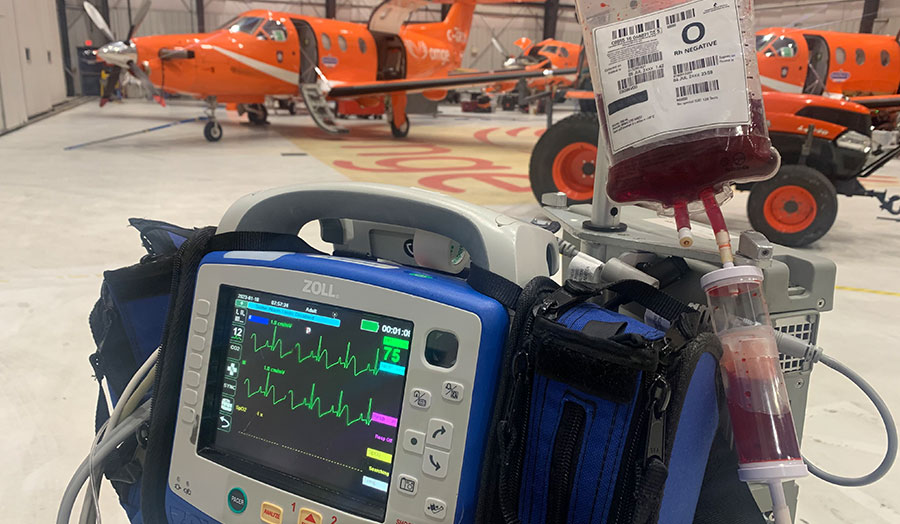Blood Efficiency Accelerator Award Program helping team establish national best practices for out-of-hospital transfusions

Canadian Blood Services has multiple competitive funding programs open to Canadian researchers that pursue projects related to our research priorities. Since 2017, Canadian Blood Services’ Blood Efficiency Accelerator Award Program (BEAP) has supported innovative research projects that seek new knowledge or accelerate the application of existing knowledge to improve the efficient and appropriate utilization of blood products, while maintaining the safety of the blood system.
Following a trauma in a remote location, an air ambulance urgently makes its way to pick up a bleeding patient. Due to their injuries and the amount of blood loss, the patient is at risk of hemorrhagic shock, but is still many miles and precious minutes away from reaching a hospital. This is one of the crucial moments when out-of-hospital transfusion may be used to help save the patient’s life.
Out-of-hospital transfusion, often abbreviated as OHBT and also known as “pre-hospital transfusion”, is the transfusion of blood components, products, or whole blood that occurs prior to a patient’s arrival at a hospital, usually during transport. In this blog, Dr. Brodie Nolan describes how Canadian Blood Services’ Blood Efficiency Accelerator Award Program (BEAP) is supporting the development of national best practices and a new registry for these lifesaving transfusions.
What does current practice for out-of-hospital blood transfusion look like in Canada?
Six critical care transport organizations can provide OHBT in Canada. Air ambulances – such as STARS in the Prairies or Ornge in Ontario – are typically where these take place. This is because each province has slightly different levels of care for paramedics, and while emergency transfusions would be in scope for advanced care flight paramedics and flight nurses in an air ambulance, they would be outside the scope of practice for most land paramedics in Canada.
As Nolan describes, “In the past, we might have had to send the flight crew into the hospital to pick up blood, then fly to the patient, then bring the patient back to the hospital. Or an already in-flight crew might be diverted to another urgent call without having time to stop to pick up blood. Over the last decade, we’ve seen that stocking the air ambulances [with blood components or products] helps to minimize the response time to get to patients and allows air ambulances to service a substantial amount of the population.”
These days, most flights are stocked with two units of O-negative red blood cells, though some services carry red blood cells and plasma. In the three years that Ornge has carried blood on board, (and only since April 2023 in Northern Ontario), they have already provided life-saving transfusions to over 150 patients.
“Not only do air ambulances have the greatest distances to cover, they tend to be needed by the sickest patients. If we look at the reason why OHBT has evolved, it came from a trauma lens. The idea of stocking air ambulances with blood is to try to help bridge these patients to get to the hospital for the definitive care needed for survival.”
Why is research into OHBT in Canada important?
In Canada, the unique geography and number of rural and remote areas are part of what make OHBT so important for patients. “Here, many helicopter scene calls that we are doing are 30 to 40-minute flights one way, while fixed-wing resources (planes) may be going hours for patients. In the Ontario setting, from a geographic angle, we have 9 adult lead trauma hospitals across the province, with about 15% of patients being more than a 60-minute flight away from a lead trauma hospital.”
Studying OHBT in Canada to understand how they are carried out and whether there is a gap between protocols and practice can improve transfusion practice for patients in the future. Understanding more about OHBT is also important when it comes to the efficient use of Type O-negative blood, the type that is universally received and therefore very precious to maintain in the national supply.

What is CAN-PATT and how did you become involved in this research?
More than a dozen members of the pan-Canadian network known as CAN-PATT – short for Canadian Prehospital and Transport Transfusion – have been involved on the BEAP project team.
Says Nolan, “In CAN-PATT, I am an Ontario representative for Ornge. My background is in emergency medicine with a specialisation in trauma and transport medicine, and my Masters studies focused on understanding how systems can minimize delays to care through a trauma lens. While diving into access to care, you find that access to blood is a huge issue, and I found this research particularly interesting because of the relevance to Ornge’s Blood on Board program.”
What did your BEAP-supported study aim to do?
BEAP support first helped the team to establish national best practices for OHBT based on 39 recommendations obtained from national subject matter experts in a Delphi study. Then, the team looked at how closely current practices compared to these recommendations to identify opportunities for improvement and standardization.
The resulting publication, published in the peer-reviewed journal Resuscitation Plus in December 2023, found that there is strong alignment between current practices and recommendations for OHBT in Canada. However, it also highlighted opportunities for improvement around indication and cessation criteria for transfusions – essentially when they should be started and stopped – as survey results showed more variability and ambiguity in these areas.
-
Read the full, open-access publication online: A comparative analysis of current out-of-hospital transfusion protocols to expert recommendations
How do the next steps build on the team’s initial research?
In the most recent BEAP competition, the team has received additional funding to complete complementary research that brings together the minds of CAN-PATT around the development of a registry for the data about OHBTs, ideally linked to in-hospital data for patients. Doing so can provide important information for assessing the safety and efficacy of blood transfusions in out-of-hospital settings.
Says Nolan, “In the emergency and trauma backgrounds I come from, I know that we have fairly established registries that capture a lot of useful information about treatment. One of my goals with CAN-PATT is to see if we can create a similar registry that could gather information such as where we are transfusing, what the patients’ needs and blood type are, etc. That information could help inform our understanding of which products are needed most for OHBT, along with how and where we stock them.”
Canadian Blood Services funds many innovative research projects through competitive funding programs. To learn more about other currently funded projects, visit Blood.ca.
Canadian Blood Services – Driving world-class innovation
Through discovery, development and applied research, Canadian Blood Services drives world-class innovation in blood transfusion, cellular therapy and transplantation—bringing clarity and insight to an increasingly complex healthcare future. Our dedicated research team and extended network of partners engage in exploratory and applied research to create new knowledge, inform and enhance best practices, contribute to the development of new services and technologies, and build capacity through training and collaboration. Find out more about our research impact.
The opinions reflected in this post are those of the author and do not necessarily reflect the opinions of Canadian Blood Services nor do they reflect the views of Health Canada or any other funding agency.